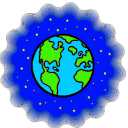| 1. |
a large body of salt water. The earth contains four that together cover 75% of our planet's surface.
ocean |
|
| 2. |
the study of the earth's crust, strata, and especially rocks.
_________________ |
|
| 3. |
The shape or configuration of the earth's surface
_________________ |
|
| 4. |
the study of the earth, with the mountains, bodies of water, countries, and people.
_________________ |
|
| 5. |
the parallel of latitude that is north of the equator. Land lying near this imaginary line stays warm year-round.
_________________ |
|
| 6. |
the low land between hills.
_________________ |
|
| 7. |
a wide, fairly flat expanse of treeless country. Good land for farming or raising cattle.
_________________ |
|
| 8. |
the parallel ring of latitude that limits the area around the South Pole which has midnight sun. The sun doesn't rise on the summer solstice, and it doesn't set on the winter solstice. It is near the South Pole.
_________________ |
|
| 9. |
Half of the earth's surface. There are four possible halves, depending on which way you divide the Earth, Northern and Southern (divided by the equator) and the Eastern and Western (divided by the Prime Meridian and 180�)
_________________ |
|
| 10. |
part of an ocean or sea that extends into a land mass. A large one exists south of the U.S. and east of Mexico.
_________________ |
|
| 11. |
a land mass that is higher than a hill.
_________________ |
|
| 12. |
a book of maps. Travelers often carry one on trips.
_________________ |
|
| 13. |
a usually large and level land area that is raised above adjacent land on at least one side. The name comes from a French word meaning "flat."
_________________ |
|
| 14. |
one of the seven very large land masses of the world.
_________________ |
|
| 15. |
An independent political entity, also known as a state.
_________________ |
|
| 16. |
distance east and west on the Earth's surface measured from a certain place, estimated in degrees.
_________________ |
|
| 17. |
distance on the Earth's surface as measured by degrees north or south from the equator.
_________________ |
|
| 18. |
the parallel ring of latitude where the Sun does not set on the day of the summer solstice, and does not rise on the day of the winter solstice. It is near the North Pole.
_________________ |
|
| 19. |
a deep valley with high, steep slopes. It often has a stream running through it. There is a grand one in the western U.S.
_________________ |
|
| 20. |
A chain or set of islands grouped together
_________________ |
|
| 21. |
dry land that receives very little rainfall and has little vegetation.
_________________ |
|
| 22. |
narrow neck of land connecting two larger land areas. Canals are often cut through them to allow boats to cross to the other side.
_________________ |
|



